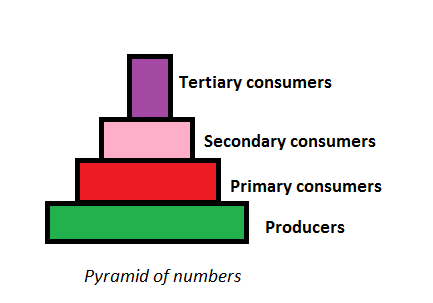Table of Contents
- What is an Ecological Pyramid?
- Types of Ecological Pyramid
- Importance of Ecological Pyramid
- Limitations of Ecological Pyramid
What is an Ecological Pyramid?
An ecological pyramid is a graphical representation of the relationship between the different living organisms at different trophic levels. Charles Elton developed the concept of the pyramid of numbers. Later, G.Evylen Hutchinson and Raymond Lindeman developed the idea of the pyramid of energy or productivity.
It can be observed that these pyramids are in the shape of actual pyramids, with the base being the broadest, which is covered by the lowest trophic level, i.e., producers. The next level is occupied by the next trophic level, i.e., the primary consumers and so on.
All the calculations for construction of these types of ecological pyramids must take into account all the organisms in a particular trophic level because a sample space of a few numbers or a few species will end up giving a huge level of errors.

Also Read: Ecology
Types of Ecological Pyramid
Three types of ecological pyramids exist. They are as follows:
Pyramid of Numbers

Pyramid of Numbers
In this type of ecological pyramid, the number of organisms in each trophic level is considered as a level in the pyramid. The pyramid of numbers is usually upright except for some situations like that of the detritus food chain, where many organisms feed on one dead plant or animal.
Pyramid of Biomass

Pyramid of Biomass
In this particular type of ecological pyramid, each level takes into account the amount of biomass produced by each trophic level. The pyramid of biomass is also upright except for that observed in oceans where large numbers of zooplanktons depend on a relatively smaller number of phytoplanktons.
Pyramid of Energy

Pyramid of Energy
Pyramid of energy is the only type of ecological pyramid, which is always upright as the energy flow in a food chain is always unidirectional. Also, with every increasing trophic level, some energy is lost into the environment.
Importance of Ecological Pyramid
The importance of ecological pyramid can be explained in the following points:
- They show the feeding of different organisms in different ecosystems.
- It shows the efficiency of energy transfer.
- The condition of the ecosystem can be monitored, and any further damage can be prevented.
Limitations of Ecological Pyramid
- More than one species may occupy multiple trophic levels as in case of the food web. Thus, this system does not take into account food webs.
- The saprophytes are not considered in any of the pyramids even though they form an important part of the various ecosystem.
- These pyramids are applicable only to simple food chains, which usually do not occur naturally.
- These pyramids do not deliver any concept in relation to variations in season and climate.
- They do not consider the possibility of the existence of the same species at different levels.
Also Read: Energy Flow in Ecosystem
To know more about what is an ecological pyramid and its types, keep visiting BYJU’S website or download BYJU’S app for further reference.
Frequently Asked Questions
What are the three types of ecological pyramids?
The three types of ecological pyramids include:
- Pyramid of Number
- Pyramid of Biomass
- Pyramid of Energy
What do you understand by an ecological pyramid?
An ecological pyramid is a graphical representation showing the relationship between different organisms in an ecosystem. It shows the flow of energy at different trophic levels in an ecosystem.
What is the 10% law?
The 10% law was given by Raymond Lindeman. This law states that when energy is transferred from one trophic level to the other, only 10% energy from the organic matter is passed on.
Why is the pyramid of energy always upright?
Pyramid of energy is a type of ecological pyramid that is always upright. This is due to the fact that during the flow of energy from one trophic level to the other, some energy is always lost as heat in each step.
Why are there less number of organisms at the top of the ecological pyramid?
There are less number of organisms at the top of the pyramid because there is very little food left for secondary consumers compared to the primary consumers. Similarly, there are fewer consumers than producers.

This cleared my doubts
Wow nice information
quick question: Isn’t energy lost just by the organisms using it?
its very helpful to clear our doubts in correct way.
Byjus is very helpful